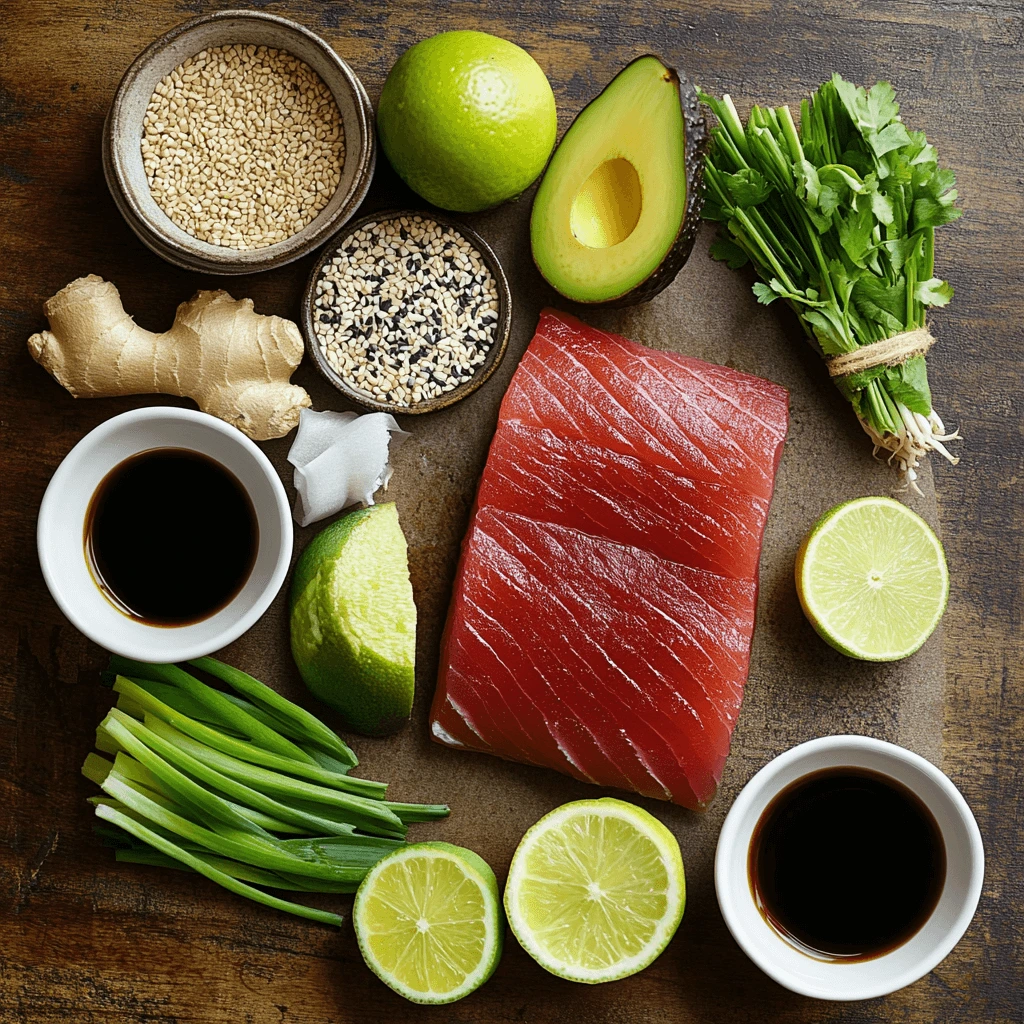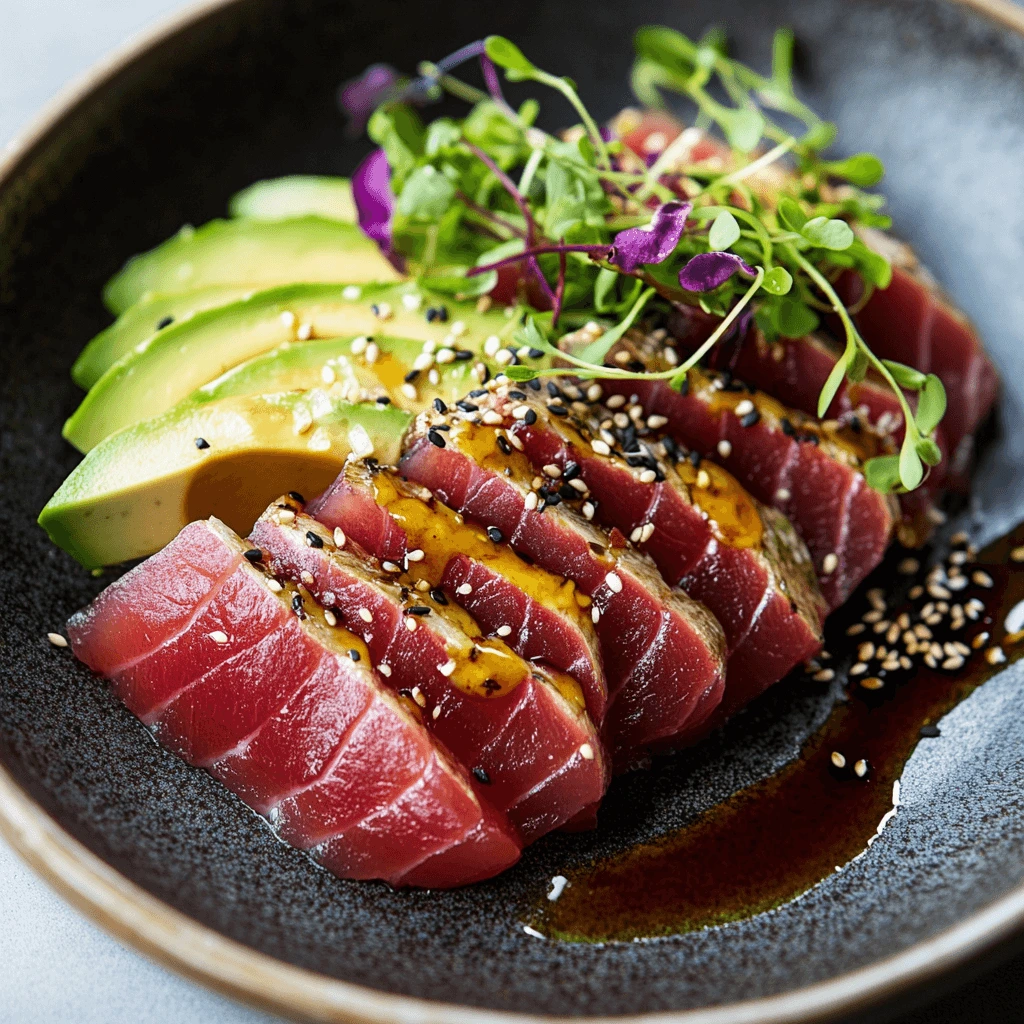If you’re looking for a fresh and healthy way to enjoy ahi tuna, this Best Ahi Tuna Recipe is perfect for you! Unlike traditional seared ahi tuna, this dish keeps the fish in its natural, raw state, allowing you to fully appreciate its delicate flavor and buttery texture.
Ahi tuna, also known as Yellowfin or Bigeye tuna, is a high-protein, omega-3-rich fish that pairs beautifully with light, flavorful ingredients like soy sauce, sesame oil, and citrus marinades. Whether you’re making a poke bowl, tartare, or sashimi-style dish, this no-sear ahi tuna recipe is incredibly easy to prepare and perfect for seafood lovers.
In this guide, I’ll show you how to choose the best sashimi-grade ahi tuna, prepare a delicious marinade, and serve it in a variety of creative ways—all without needing to sear the fish. Let’s get started!
More Internet-Famous Recipes
What Makes Ahi Tuna a Great Choice?

Ahi tuna is a popular and highly prized fish in many cuisines, especially in Japanese and Hawaiian dishes. Not only does it have a mild flavor, but it also boasts a firm texture and deep red color, making it a favorite for raw preparations. For instance, it is commonly served in dishes like sashimi, poke bowls, and tartare. However, ahi tuna can also be cooked in various ways while still preserving its delicate taste.
One excellent method is using an air fryer, which offers a quick and flavorful way to prepare it. If you’re interested in trying this method, check out this guide on How to Cook Ahi Tuna in an Air Fryer for an easy and delicious recipe. Unlike other types of tuna, ahi is best enjoyed fresh or lightly cooked, ensuring it retains its high nutritional value and rich taste.
Types of Ahi Tuna
The term “ahi tuna” actually refers to two different species of tuna:
- Yellowfin Tuna (Thunnus albacares) – This is the more common type of ahi tuna. It has a slightly milder flavor and a firmer texture compared to Bigeye tuna. Yellowfin tuna is often used in poke bowls, sushi, and grilled dishes.
- Bigeye Tuna (Thunnus obesus) – Slightly fattier than Yellowfin, Bigeye tuna has a richer taste and a softer texture, making it ideal for raw dishes like sashimi and tartare.
Both varieties are excellent choices for raw and lightly prepared dishes, but sashimi-grade ahi tuna is essential for ensuring safety and the best possible taste.
What Does “Sashimi-Grade” Mean?
If you’re planning to enjoy ahi tuna without searing it, it’s crucial to buy sashimi-grade or sushi-grade tuna. This label means that the fish has been handled, frozen, and stored under strict food safety guidelines to reduce the risk of parasites or bacteria. Look for deep red, firm, and fresh-smelling ahi tuna from reputable fish markets or grocery stores.
The Benefits of Choosing Ahi Tuna
Ahi tuna is not only delicious but also packed with health benefits:
High in Protein – Ahi tuna is an excellent source of lean protein, making it perfect fr a healthy diet.
Rich in Omega-3 Fatty Acids – These essential fats help support heart health, brain function, and reduce inflammation.
in Calories and Fat – Unlike many other protein sources, ahi tuna is naturally low in fat, especially when eaten raw.
Versatile and Easy to Prepare – Whether in a poke bowl, tartare, or sushi, ahi tuna pairs well with a variety of flavors.
Quick to Make – Since this recipe doesn’t require cooking or searing, you can prepare a delicious ahi tuna dish in minutes.
Key Ingredients for a Flavorful Ahi Tuna Dish

Creating the best ahi tuna recipe starts with selecting high-quality ingredients that enhance the fish’s natural flavor while keeping the dish fresh and healthy. Since this recipe does not require searing, the focus is on raw preparation, meaning that ingredient quality is even more crucial. Below, we’ll cover the main ingredients, optional add-ins, and tips for sourcing the freshest sashimi-grade tuna.
1. Main Ingredients for the Best Ahi Tuna Recipe
These core ingredients form the base of a delicious, well-balanced ahi tuna dish:
- Sashimi-Grade Ahi Tuna – The star of the recipe! Choose Yellowfin or Bigeye tuna with a deep red color, firm texture, and fresh ocean scent. This ensures both safety and the best flavor when eating it raw.
- Soy Sauce or Tamari – Adds a rich umami depth to the dish. Tamari is a great gluten-free alternative with a slightly less salty taste.
- Sesame Oil – A small amount of toasted sesame oil enhances the tuna’s flavor, giving it a warm, nutty aroma.
- Rice Vinegar – Balances the richness of the tuna with a mild, tangy acidity. It’s commonly used in sushi rice and poke bowls.
- Fresh Ginger – Grated or finely chopped, ginger adds a fresh, slightly spicy kick that complements raw tuna beautifully.
- Garlic – Minced or crushed garlic enhances the depth of flavor, giving the dish a subtle sharpness.
- Green Onions (Scallions) – Provides a mild oniony flavor and a pop of freshness. Best sliced thinly for garnish.
- Sesame Seeds – Lightly toasted sesame seeds add a crunchy texture and a nutty contrast to the tender tuna.
- Lime or Lemon Juice – A splash of citrus brightens up the dish and helps cut through the richness of the fish.
2. Optional Additions for Extra Flavor & Texture
Want to take your ahi tuna dish to the next level? Consider adding these flavorful ingredients:
- Ponzu Sauce – A citrusy soy sauce that adds a sweet, tangy twist to your marinade.
- Wasabi – If you love heat, a small dab of wasabi paste adds a sharp, spicy kick.
- Honey or Maple Syrup – A touch of sweetness can balance acidity and enhance the marinade.
- Avocado – Creamy and rich, avocado pairs beautifully with raw tuna, making it a great addition to poke bowls or salads.
- Seaweed (Nori or Wakame) – Crushed nori sheets or wakame seaweed salad add a salty, umami-rich contrast to the dish.
- Cucumber – Thinly sliced cucumber brings a cool, crisp texture that complements the tuna’s soft bite.
3. Where to Buy the Best Sashimi-Grade Ahi Tuna
Because this ahi tuna recipe doesn’t require searing, buying high-quality sashimi-grade tuna is essential for safety and flavor. Here are the best places to find it:
- Japanese or Asian Markets – Many Japanese grocery stores specialize in sushi-grade seafood and often have the freshest selections.
- Local Fish Markets – Ask your fishmonger for sashimi-grade or sushi-grade tuna to ensure it’s safe to eat raw.
- Online Seafood Retailers – Several trusted online suppliers ship frozen sashimi-grade ahi tuna directly to your home.
- High-End Supermarkets – Some specialty stores like Whole Foods carry frozen sushi-grade tuna in their seafood section.
Step-by-Step Guide to Preparing Fresh Ahi Tuna

Preparing ahi tuna without searing is incredibly simple and requires minimal effort. Since we’re keeping the tuna raw, the focus is on choosing fresh, high-quality fish, proper slicing techniques, and balancing flavors through marination. This step-by-step guide will help you create a delicious ahi tuna dish that’s perfect for poke bowls, sushi, sashimi, or tartare.
1: Selecting and Preparing Fresh Quality Fish
Before you start, it’s essential to select the right ahi tuna to ensure both safety and great taste:
- Look for sashimi-grade tuna – Since this dish is raw, the fish must be labeled “sushi-grade” or “sashimi-grade” to meet food safety standards.
- Check for freshness – The tuna should be deep red or pink, have a firm texture, and smell fresh (not overly fishy).
- Keep it cold – Store the tuna in the fridge until you’re ready to prepare it. For the best texture, slice it while it’s slightly chilled.
Prepping the Tuna:
- Pat dry the tuna with a paper towel to remove excess moisture.
- Use a sharp knife to make clean, precise cuts. A dull knife can damage the delicate texture of the fish.
- Place the tuna on a clean cutting board, preferably one dedicated to raw seafood to prevent cross-contamination.
2: Slicing the Tuna Properly
The way you cut the ahi tuna depends on how you plan to serve it:
Sashimi or Nigiri: Slice the tuna into thin, even pieces (about ¼ inch thick).
Poke Bowls or Tartare: Dice the tuna into small cubes (about ½ inch pieces) for a tender, melt-in-your-mouth texture.
Ahi Tuna Carpaccio: Slice the tuna paper-thin, then lightly pound it to create an elegant presentation.
Pro Tip: Always slice against the grain to maintain a smooth, tender texture.
3: Making the Perfect Marinade
A great marinade enhances the natural flavors of the tuna without overpowering them. Here’s a simple yet flavorful marinade recipe:
Ahi Tuna Marinade Ingredients:
- ¼ cup soy sauce (or tamari for gluten-free)
- 1 tbsp sesame oil (for a nutty aroma)
- 1 tbsp rice vinegar (adds a slight tanginess)
- 1 tsp grated fresh ginger (for a warm, slightly spicy kick)
- 1 tsp minced garlic (enhances umami flavor)
- ½ tsp honey or maple syrup (optional, for a hint of sweetness)
- 1 tbsp fresh lime or lemon juice (brightens the flavors)
- 1 tbsp chopped green onions (for a mild oniony crunch)
- 1 tsp sesame seeds (toasted for extra nuttiness)
How to Marinate the Tuna:
- In a mixing bowl, whisk together all marinade ingredients.
- Add the cubed or sliced ahi tuna to the bowl and toss gently to coat.
- Cover and let the tuna marinate in the fridge for 10-15 minutes (avoid over-marinating, as the acidity can start to “cook” the tuna, like in ceviche).
4: Serving Ideas for Ahi Tuna
Once your ahi tuna is marinated, it’s time to serve it in a fresh, delicious way! Here are a few ideas:
- Sashimi-Style: Arrange the sliced tuna on a plate with wasabi, soy sauce, and pickled ginger on the side.
- Poke Bowl: Serve the marinated tuna over a bowl of steamed rice, avocado, cucumbers, edamame, and seaweed for a Hawaiian-inspired dish.
- Ahi Tuna Tartare: Finely dice the tuna and mix with avocado, sesame oil, and a touch of ponzu sauce for an elegant appetizer.
- Lettuce Wraps: Wrap the tuna in fresh lettuce leaves with shredded carrots and a drizzle of spicy mayo for a low-carb option.
Pro Tip: Garnish with extra sesame seeds, microgreens, or sliced chilies for added texture and color.
5: Storing Leftover Ahi Tuna
Since this recipe features raw fish, proper storage is crucial:
- Refrigerate immediately: Store any leftovers in an airtight container and keep them in the fridge.
- Consume within 24 hours: Ahi tuna is best eaten fresh; after a day, the texture and flavor may deteriorate.
- Avoid freezing marinated tuna: The marinade can alter the texture when frozen. If needed, freeze the fish before marinating.
Delicious Ways to Enjoy Raw Ahi Tuna
Ahi tuna is incredibly versatile, and there are plenty of ways to enjoy it while preserving its fresh, buttery texture. Since this recipe does not involve searing, the focus remains on raw preparations that highlight the natural flavors of the fish. Below are some of the best ways to serve and savor ahi tuna.
1. Classic Ahi Tuna Poke Bowl
A poke bowl is one of the most popular ways to enjoy raw ahi tuna. Originally from Hawaii, this dish features marinated tuna served over rice with fresh toppings, creating a well-balanced meal.
How to Make a Poke Bowl:
- First, choose a base: Steamed white rice, brown rice, sushi rice, or cauliflower rice work well.
- Next, prepare the tuna: Dice the fish into bite-sized cubes and marinate it with soy sauce, sesame oil, rice vinegar, and green onions.
- Then, add fresh toppings: Avocado, edamame, cucumbers, shredded carrots, mango, or radish will enhance the texture and flavor.
- After that, drizzle with sauces: Spicy mayo, ponzu sauce, or a light ginger dressing bring out the best in the dish.
- Finally, garnish for extra crunch: Sprinkle sesame seeds, nori flakes, or crispy onions before serving.
Why You’ll Love It:
- Not only is it customizable, but it’s also quick to make.
- Besides being nutritious, it’s packed with protein and omega-3s.
- Best of all, you can prepare it in under 10 minutes.
2. Ahi Tuna Tartare
For a more refined dish, consider making ahi tuna tartare. This elegant appetizer enhances the natural flavor of the tuna with simple yet bold ingredients.
How to Make Ahi Tuna Tartare:
- To start, finely dice sashimi-grade ahi tuna into small, even pieces.
- Next, mix with seasonings: A combination of soy sauce, lime juice, sesame oil, shallots, and a touch of Dijon mustard will add depth.
- Then, stir in diced avocado for a smooth contrast to the firm texture of the fish.
- Finally, serve with style: Use a round mold for presentation or spoon the tartare onto toasted crostini or cucumber slices.
Why This Works:
- Not only is it light and flavorful, but it’s also perfect for entertaining.
- The mix of umami, citrus, and creamy textures creates a well-balanced bite.
- It pairs exceptionally well with white wine or sparkling sake.
3. Spicy Ahi Tuna Lettuce Wraps
If you’re looking for a low-carb and refreshing option, lettuce wraps are an excellent choice. These wraps offer a crisp contrast to the soft, marinated tuna, making them a satisfying yet healthy meal.
How to Make Spicy Ahi Tuna Lettuce Wraps:
- First, chop the tuna into small, bite-sized cubes.
- Then, toss it with a spicy sauce: Mix the tuna with sriracha mayo, sesame oil, and lime juice for bold flavor.
- Next, spoon the mixture into lettuce cups: Butter lettuce or romaine leaves work best.
- Finally, add fresh toppings: Thinly sliced cucumbers, shredded carrots, and chopped scallions enhance both the texture and taste.
Why This Works:
- Not only are these wraps low in carbs, but they are also high in protein.
- They are quick and easy to put together, making them great for busy days.
- Since they are light yet flavorful, they make an excellent appetizer or meal.
4. Ahi Tuna Sushi Rolls
If you prefer a more traditional approach, homemade sushi rolls allow you to enjoy ahi tuna in a classic Japanese style.
How to Prepare Fresh Fish Sushi Rolls:
- First, prepare the sushi rice: Cook it and season it with rice vinegar, sugar, and salt.
- Next, lay out a sheet of nori: Spread a thin layer of sushi rice on top.
- Then, add the ahi tuna slices: Along with avocado, cucumber, and a drizzle of spicy mayo.
- After that, roll it tightly: Use a bamboo sushi mat if you have one.
- Finally, slice into bite-sized pieces and serve with soy sauce and wasabi.
Why This Works:
- Not only is it a fun way to enjoy tuna, but it’s also easy to customize.
- The combination of creamy, crunchy, and umami flavors creates a satisfying meal.
- Best of all, it pairs perfectly with pickled ginger and miso soup.
5. Ahi Tuna Ceviche
Ceviche is another fantastic way to enjoy raw ahi tuna. The citrus marinade naturally enhances the freshness of the fish while adding a bright, tangy flavor.
How to Prepare a Fresh and Flavorful Fish Ceviche
- To begin, cut the tuna into small cubes and place them in a bowl.
- Then, marinate with fresh citrus juice: Lime and lemon juice slightly “cook” the fish while adding a refreshing tang.
- Next, add finely chopped ingredients: Red onions, cilantro, jalapeño, and diced tomatoes will enhance the texture and spice level.
- After that, let it chill: Allow the flavors to meld for at least 15 minutes before serving.
- Finally, serve with tortilla chips or plantain chips for a crunchy contrast.
Why This Works:
- Not only is it light and refreshing, but it’s also packed with bold flavors.
- The acidity of the citrus perfectly balances the richness of the tuna.
- Since it requires no cooking, it’s quick and effortless to prepare.


There are definitely loads of details like that to take into consideration. That could be a great level to deliver up. I provide the thoughts above as general inspiration however clearly there are questions like the one you convey up the place a very powerful thing will probably be working in honest good faith. I don?t know if best practices have emerged around issues like that, however I’m positive that your job is clearly identified as a fair game. Each girls and boys feel the impact of just a second’s pleasure, for the rest of their lives.